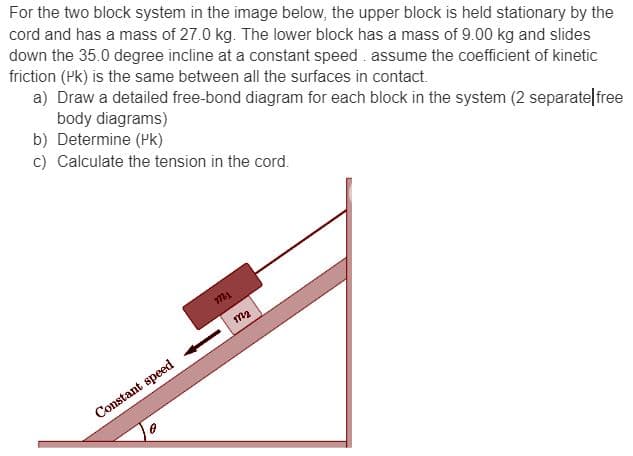For the two block system in the image below, the upper block is held stationary by the cord and has a mass of 27.0 kg. The lower block has a mass of 9.00 kg and slides down the 35.0 degree incline at a constant speed. assume the coefficient of kinetic friction (PK) is the same between all the surfaces in contact. a) Draw a detailed free-bond diagram for each block in the system (2 separate free body diagrams) b) Determine (PK) c) Calculate the tension in the cord.
For the two block system in the image below, the upper block is held stationary by the cord and has a mass of 27.0 kg. The lower block has a mass of 9.00 kg and slides down the 35.0 degree incline at a constant speed. assume the coefficient of kinetic friction (PK) is the same between all the surfaces in contact. a) Draw a detailed free-bond diagram for each block in the system (2 separate free body diagrams) b) Determine (PK) c) Calculate the tension in the cord.
Principles of Physics: A Calculus-Based Text
5th Edition
ISBN:9781133104261
Author:Raymond A. Serway, John W. Jewett
Publisher:Raymond A. Serway, John W. Jewett
Chapter8: Momentum And Collisions
Section: Chapter Questions
Problem 6CQ: A juggler juggles three balls in a continuous cycle. Any one ball is in contact with one of his...
Related questions
Question

Transcribed Image Text:For the two block system in the image below, the upper block is held stationary by the
cord and has a mass of 27.0 kg. The lower block has a mass of 9.00 kg and slides
down the 35.0 degree incline at a constant speed. assume the coefficient of kinetic
friction (PK) is the same between all the surfaces in contact.
a) Draw a detailed free-bond diagram for each block in the system (2 separate free
body diagrams)
b) Determine (PK)
c) Calculate the tension in the cord.
Constant speed
mi
m2
Expert Solution
This question has been solved!
Explore an expertly crafted, step-by-step solution for a thorough understanding of key concepts.
Step by step
Solved in 2 steps with 2 images

Knowledge Booster
Learn more about
Need a deep-dive on the concept behind this application? Look no further. Learn more about this topic, physics and related others by exploring similar questions and additional content below.Recommended textbooks for you

Principles of Physics: A Calculus-Based Text
Physics
ISBN:
9781133104261
Author:
Raymond A. Serway, John W. Jewett
Publisher:
Cengage Learning

Principles of Physics: A Calculus-Based Text
Physics
ISBN:
9781133104261
Author:
Raymond A. Serway, John W. Jewett
Publisher:
Cengage Learning